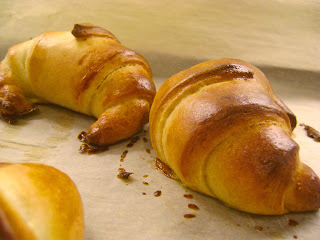I feel like I've invented a winner here. I had a can of this delicious dulce de leche-like substance (it's thicker, though) and I promised a new batch of ice cream to my siblings. To make the ice cream even better (which is hard, considering how rich and caramelly it is on its own) I added crunchy, bittersweet caramelized walnuts flavoured with expresso powder. Altogether I think it's one of my best ice creams yet.
A couple of plusses about this recipe- you need less eggs and cream than with most custard-based ice cream, because the caramel itself contributes smoothness and richness. You also will probably have leftover walnuts to eat, since the recipe below makes a lot. Instead of walnuts, you can also use pecans, and you can substitute dulce de leche as well. Consider serving with a glog of liquor on top.
Lody Kajmak
Adapted from F for Food
225 g. Kajmak/masa krówkowa, substitute dulce de leche
1 C. Milk, 3.8 %
2/3 C. Heavy cream, about 35%
3 Egg yolks
1 TBSP Brown sugar
1/2 C. Caramelized coffee walnut pieces, optional (recipe follows)
Pinch of salt
Heat milk and kajmak in a saucepan over medium heat until steaming. Separately, whisk together the sugar, yolks and salt.
Pour 1/4 C. of the hot milk mixture into the yolk mixture and whisk together well. Strain back into the remaining milk and heat while stirring frequently until thickened.
Transfer to a cool bowl and add the cream. Refrigerate overnight.
Mix in ice cream maker according to its instructions. Layer with the nut pieces in a freezer-proof container and let freeze at least 2 hours before serving.
for the caramelized coffee walnuts:
80 g. Walnut pieces
60 g. Sugar
1/2 Tsp. Expresso powder
Mix all and toast over medium-high heat until the sugar is melted and smells caramel-like. Immediately pour onto a cool tray and keep in an airtight container until ready to use.

































